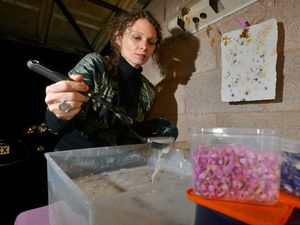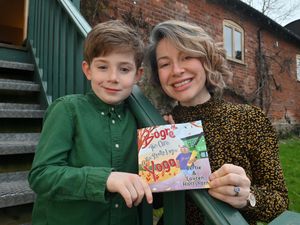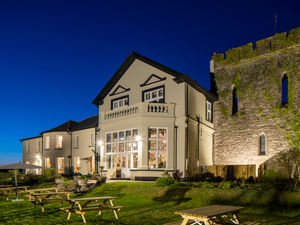Creative recycling: What it's like to be a papermaker
From recording important milestones to compiling a shopping list, paper is a huge part of our everyday lives.

And when we have finished using it, we usually throw it in the recycling bin.
Now Jemma Bryan is on a mission to give this valuable resource a new lease of life and keep it in the community.
She makes her own paper by hand using recyclable materials, waste products and natural additions such as flower petals.
By working with local businesses, Jemma, who lives in Telford, wants to recycle their paper waste into new products that they can use day to day.
The 33-year-old launched Paper Lore in the summer after a change in personal circumstances gave her the opportunity to try her hand at something new.
"I'm quite crafty and I like making things. I just decided to try making some paper. I had a memory of visiting a paper mill in Cheddar Gorge when I was young and I had seen handmade paper for sale in shops," she explains.
Inspired by the creative process, Jemma was soon brimming with ideas for the future.
The process of making paper from recyclable materials begins with ripping the scrap paper into strips.
Jemma then fills a kitchen blender with water and mixes in the paper shreds to create a pulp.
"The amount you blend it can affect the texture. It's good to experiment in different ways," she explains.
The blended pulp is then added to a vat of water - the more pulp there is, the thicker the paper will be.
Once Jemma is happy with the consistency, she will then start pulling sheets of paper using a mould and deckle.
This consists of two frames that are the same size, one with a mesh screen attached.
She dips the frames into the water and scoops up some of the pulp onto the mould screen.
Next, Jemma lets the water drain to a drop before transferring the sheet to a flat, absorbent surface, which is known as couching.
Papermaking felts are used to soak up the remaining liquid and separate sheets of wet paper while they dry.
The sheets are then transferred to a press, similar to a flower press, that removes the last of excess water and helps to compress the fibres into a solid product.
The length of time the paper stays in the presses can vary depending on the grade of material used.
Jemma then dries her sheets by sticking them to a window which creates a flat surface one side and a textured surface on the other. During the summer she used a washing line to dry them outside.
Drying indoors in autumn and winter can take a couple of days, but when the temperatures are warmer, the process takes a lot less time.
The basic paper making process can be varied to add texture and colour by using different types of materials.
Jemma likes to add what are known as inclusions to her paper pulp before she pulls sheets, such as petals from roses or buds from lavender.
"I love to use a lot of homegrown ingredients in my papers. I work part-time at Shropshire Petals so I some of their petals and I love using dried lavender from The Lavender Farm. I really creating products using materials from the natural environment and in the summer I enjoyed setting everything up in the garden, making paper and using the sun and the wind to dry it. It makes a much more natural process," she explains.
"I really enjoy creating some tangible, you can feel it, touch it, it's a physical object. I like working towards something and having a solid product at the end.
"The whole process is satisfying and I enjoy talking to people about what I can do with waste paper and the products I can make."
Jemma sells her papers, available in sizes A3, A4, A6 and 5x7 inches, through her online shop.
She also makes mycopaper, which is paper made from mushrooms, such as the birch polypore and shaggy mane varieties.
As the latter breaks down, it creates a gooey black ink which can also be used to add colour to the paper.
Jemma, who is a registered waste carrier, believes she can offer businesses a valuable service, turning their recyclable materials into new paper products.
This might include items such as packing slips or business cards and firms signing up for the scheme would be be able to buy them at a discounted rate.
By keeping the paper in the local community, Jemma says it will help to reduce the carbon footprint as it doesn't need to be transported further afield to a recycling plant.
"It's closed-loop recycling. Their waste paper gets turned into something new that they can use in their business. It's a way for them to recycle with accountability and intention," says Jemma.
Her aim is to grow Paper Lore's links with the local community and in the future she would like to have a garden where she can source her natural ingredients that would also be open to the public.
"I think making a positive contribution to the environment and a running a business is a dream of a lot of people of my generation," she tells Weekend.
For more information email Jemma at recycle@paperlore.co.uk, visit the website paperlore.co.uk or follow her updates on Instagram @paperlorerecycling





